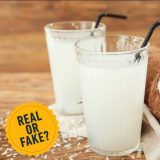If there’s no cardboard in your Parmesan, there might be strawberry leaves in your oregano. And if there’s any coconut in your coconut water, consider yourself lucky. Welcome to the wide world of food fraud, which brings in more money than narcotics, according to food detective Chris Elliott.
Elliott, who investigated the horse meat scandal in the United Kingdom, revealed how rampant food fraud is—and how he uncovers it—on Milk Street Radio. “We produce what we call food fingerprints,” Elliott explains. “So if it’s oregano, we will look at the entire molecular structure of that for just a fingerprint, and it doesn’t matter how anybody tries to cheap it—whether it’s olive leaves, strawberry or grass cuttings from their back garden—we will know that the fingerprint isn’t right. We can identify that really quickly, and some of the innovations we’re driving now is we’re trying to get some of that detection actually on smartphones, so you don’t have to send samples to the laboratory.”
Listen to the interview here to learn just how it works, and where Elliott has uncovered fraud in the past. Below, Elliott dives into those at-risk foods in excerpts from the full discussion. You might want to give your pantry a second look.
Coconut
Coconut is one of the great examples that I use because it’s a booming product. There’s been a big surge in the amount of sales and often I will ask people, “Where do you think all of the coconuts suddenly came from?” If you plant a coconut palm, it’s at least eight years before that coconut palm produces a coconut, so where do they all come from? Often the case is it’s actually not coconuts you’re buying. In a lot of cases we’ve looked at, the coconut water is water with sugar added to it; the coconut oil is different types of plant-based oils... It’s a prime example that where there’s a surge in popularity in something, it’s a remarkable trigger for fraud.
Saffron
It’s one of the world’s most expensive commodities and actually the current price of saffron is set somewhere between the price of silver and gold by weight. There’s a whole science to saffron fraud: It’s all the ways people have thought about cheating in saffron—what they can add to it, the types of dyes or bulking agents they could use...It’s a whole science in itself.
Parmesan
There was a fraud in Parmesan cheese in the U.S. just a couple of years ago and believe it or not, the parmesan was being adulterated with shredded cardboard.
Oregano
Often we will buy our oregano or other herbs in little 30-gram jars that cost $1 or $2. When you actually think of the price of oregano per ton, it’s probably about $100,000 for a ton. It’s a very, very valuable commodity and what the fraudsters do, is take some of that oregano out and put other green leafy material in. So they can make an absolute fortune out of it. For the last few years, we’ve been trailing oregano fraud in different parts of the world and the fraud is an industry in itself. The oregano will be sold and it will be adulterated with lots of different types of green leafy materials and then whenever we identify—for instance, olive leaves were very popular—then the fraudsters stop using olive leaves and start to use strawberry leaves. That’s the kind of chase that we’re on at the moment. On average in the world, we find that 25 percent of all oregano being sold has been adulterated in some way or other.
Olive Oil
There’s a massive amount of cheating that goes on in olive oil in terms of what type of oil you are actually buying. I came across a fraud in Europe going back to 2013 where there was a factory and what was going into the factory was sunflower oil and what was coming out the other end was olive oil—one of life’s miracles. What they were doing inside the factory was they were adding an extract of daffodils to sunflower oil to get the color right.
Tuna
Something that was uncovered last year—this was a very serious, very well-organized fraud in China—is tuna. Whenever you go into the store to buy tuna, you’ll judge it on the quality of the color—that lovely, bright pink color. As the fish gets older, it gets darker and darker, and what the fraudsters had done was they had bought up massive quantities of very, very old tuna, which was going to go into pet food and so forth, and they found a way to restore the pink color in it. First, that was done by all injecting some chemicals into it, and then spraying it with carbon monoxide to restore that pink color. That fraud was just uncovered last year and seemed to be linked to organized crime in different parts of the world.
This interview has been edited for clarity.



